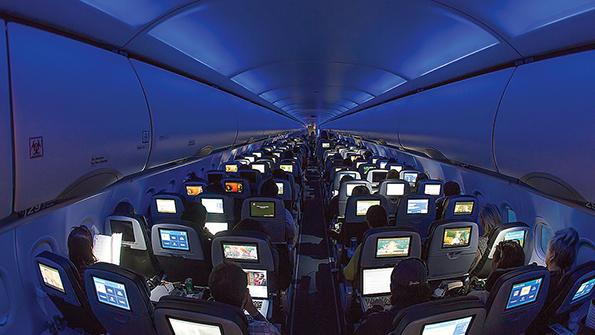
The FAA plans to begin collecting data on emergency evacuations and scrutinizing manufacturers’ data more carefully to ensure its certification standards are sufficient, but work on seat pitch is not likely to lead to major changes. It also is pushing back on an audit report’s suggestion that one part of its requirements—the 90-sec. evacuation demonstration—needs overhauling.
“Stakeholders have raised concerns about the validity of the assumptions that drive FAA’s evacuation standards and industry tests and simulations for certifying new aircraft,” a Transportation Department Inspector General (IG) report made public in September says. Lawmakers asked the IG to review the FAA’s standards, particularly in light of changes in recent years. Among them: reports of passengers pausing during evacuations to retrieve carry-on bags, shrinking seat pitches, larger passengers and more emotional-support animals flying.
The FAA introduced a 90-sec. evacuation demonstration requirement in 1967. It has been updated five times since, but only after accidents and only once in the last two decades.
Critics contend that the lack of real-world parameters used in the tests, such as the participants’ demographics and the FAA’s acceptance of modeling data in lieu of real tests, limits their usefulness. The IG also says the agency should be using data collected from sources other than accidents to update the requirements.
“FAA largely updates its evacuation standards only after accidents, and its last update that was based on an accident occurred in 1991,” the IG says. “FAA also has not conducted sufficient research on passenger behaviors and seat dimensions to determine how they affect evacuation standards.”
The agency countered that timely evacuations are only one factor in accident survivability. Other parameters, such as flammability standards, have continued to evolve, contributing to improved safety standards and lower fatalities in all accident scenarios, it contends.
“The 90-sec. evacuation standard does not represent all accidents, because many variables are present in real-world evacuations, and accident scenarios vary widely,” the FAA told the IG in a response to the report. “Numerous requirements apply to evacuation, including addressing occupant protection, prolonging the time for egress and enabling faster egress. The report is largely silent on these requirements and focuses only on what is addressed in the full-scale evacuation demonstration. Thus, the draft report creates the impression that the full-scale demonstration is the most important component; however, that conclusion is not consistent with a systems approach to the evaluation of evacuation requirements.”
The FAA has begun a seat-pitch study in response to a 2018 congressional mandate that wants the agency to mandate minimum pitch, length and width. But the agency says such rules are not required because of other regulations, notably FAR Part 25.562, related to evacuation standards. Among them is a requirement that there must be at least 9 in. between the front of one seat and the nearest point on the back of the next seat. Seat bottoms have measured 18 in. front-to-back since the 1980s, the agency adds. Combining the two factors creates 27 in. of space.
An Emergency Evacuation Standards Aviation Rulemaking Committee (ARC) of industry experts has completed a report on evacuation requirements, actual evacuations and seat-pitch testing. The FAA is reviewing the report.
The agency has no plans to study carry-on baggage retrieval or the ramifications of emotional-support animals on evacuations.
The IG recommends that the FAA start collecting evacuation data as well as analyzing information supplied by manufacturers to ensure it is “accurate and up-to-date.” The FAA says it plans to implement both recommendations by the end of 2021.


